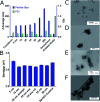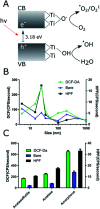Effects of core titanium crystal dimension and crystal phase on ROS generation and tumour accumulation of transferrin coated titanium dioxide nanoaggregates
- PMID: 32774845
- PMCID: PMC7409989
- DOI: 10.1039/d0ra01878c
Effects of core titanium crystal dimension and crystal phase on ROS generation and tumour accumulation of transferrin coated titanium dioxide nanoaggregates
Abstract
Radionuclide-stimulated therapy (RaST), which is enhanced by Cherenkov radiation, has enabled deep tissue stimulation of UV photosensitizers, providing a new path for cancer treatment. Previous reports have shown UV-active titanium dioxide (TiO2) nanoparticles (NPs) modified with transferrin inhibit tumour growth after orthogonal treatment with Cherenkov radiation-emitting radionuclides such as 18F-fluorodeoxyglucose (FDG). However, poor understanding of TiO2 NP parameters on reactive oxygen species (ROS) generation and particle distribution limits effective therapy. Here we sought to delineate the effects of crystal phase and core TiO2 crystal dimension (cTd) on ROS production and particle morphology. We prepared Transferrin (Tf)-TiO2 nanoaggregates (NAGs) using solvothermally synthesized cTd sizes from 5 to 1000 nm diameter and holo- or apo-transferrin. Holo-transferrin was unable to stabilize TiO2 NPs while apo-transferrin stabilized TiO2 into uniform nanoaggregates (NAGs), which were invariant with differing cTd, averaging 116 ± 1.04 nm for cTds below 100 nm. ROS production increased from 5 to 25 nm cTd, attaining a peak at 25 nm before decreasing with larger sizes. The supra-25 nm ROS production decrease was partially driven by a ~1/r 3 surface area decline. Additionally, amorphous TiO2 of equal core size exhibited a 2.6-fold increase in ROS production compared to anatase NAGs, although limited stability halted further use. Although both 5 and 25 nm anatase cTds formed similarly sized NAGs, 5 nm anatase showed a four-fold higher tumour-to-muscle ratio than the 25 nm NPs in tumour-bearing mice, demonstrating the intricate relationships between physical and biological properties of NAGs. The combined in vivo and ROS results demonstrate that anatase crystals and cTd size of 25 nm or less are ideal particle parameters to balance biodistribution with ROS production efficiency.
Conflict of interest statement
Conflicts of interest There are no conflicts to declare.
Figures





Similar articles
-
Analysis of Stable Chelate-free Gadolinium Loaded Titanium Dioxide Nanoparticles for MRI-Guided Radionuclide Stimulated Cancer Treatment.Curr Anal Chem. 2022 Aug;18(7):826-835. doi: 10.2174/1573411018666220321102736. Epub 2022 Jun 10. Curr Anal Chem. 2022. PMID: 36561765 Free PMC article.
-
Nano titanium dioxide induces the generation of ROS and potential damage in HaCaT cells under UVA irradiation.J Nanosci Nanotechnol. 2010 Dec;10(12):8500-7. doi: 10.1166/jnn.2010.2682. J Nanosci Nanotechnol. 2010. PMID: 21121359
-
Impact of titanium dioxide particle size on macrophage production of intracellular reactive oxygen species.Arch Oral Biol. 2021 Jul;127:105133. doi: 10.1016/j.archoralbio.2021.105133. Epub 2021 Apr 26. Arch Oral Biol. 2021. PMID: 33933922
-
Titanium Dioxide Nanoparticles: a Risk for Human Health?Mini Rev Med Chem. 2016;16(9):762-9. doi: 10.2174/1389557516666160321114341. Mini Rev Med Chem. 2016. PMID: 26996620 Review.
-
Titanium dioxide and zinc oxide nanoparticles in sunscreens: focus on their safety and effectiveness.Nanotechnol Sci Appl. 2011 Oct 13;4:95-112. doi: 10.2147/NSA.S19419. Nanotechnol Sci Appl. 2011. PMID: 24198489 Free PMC article. Review.
Cited by
-
Activation of nano-photosensitizers by Y-90 microspheres to enhance oxidative stress and cell death in hepatocellular carcinoma.Sci Rep. 2022 Jul 26;12(1):12748. doi: 10.1038/s41598-022-17185-0. Sci Rep. 2022. PMID: 35882949 Free PMC article.
-
Cancer-targeted pro-theranostic bi-metallic organo-coordination nanoparticles.Theranostics. 2025 Jan 1;15(4):1205-1220. doi: 10.7150/thno.99863. eCollection 2025. Theranostics. 2025. PMID: 39816680 Free PMC article.
-
Transferrin receptor in primary and metastatic breast cancer: Evaluation of expression and experimental modulation to improve molecular targeting.PLoS One. 2023 Dec 20;18(12):e0293700. doi: 10.1371/journal.pone.0293700. eCollection 2023. PLoS One. 2023. PMID: 38117806 Free PMC article.
-
Analysis of Stable Chelate-free Gadolinium Loaded Titanium Dioxide Nanoparticles for MRI-Guided Radionuclide Stimulated Cancer Treatment.Curr Anal Chem. 2022 Aug;18(7):826-835. doi: 10.2174/1573411018666220321102736. Epub 2022 Jun 10. Curr Anal Chem. 2022. PMID: 36561765 Free PMC article.
-
Orthogonal targeting of osteoclasts and myeloma cells for radionuclide stimulated dynamic therapy induces multidimensional cell death pathways.Theranostics. 2021 Jun 22;11(16):7735-7754. doi: 10.7150/thno.60757. eCollection 2021. Theranostics. 2021. PMID: 34335961 Free PMC article.
References
-
- Allison R. R. Cuenca R. Downie G. H. Randall M. E. Bagnato V. S. Sibata C. H. Photodiagn. Photodyn. Ther. 2005;2:51–63. - PubMed
-
- Verma R. S. and Bonavida B., Resistance to Targeted Anti-Cancer Therapeutics, 2015, vol. 6
Grants and funding
LinkOut - more resources
Full Text Sources
Miscellaneous

